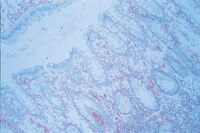Kinetics and characterization of intercellular adhesion molecule-1 (ICAM-1) expression on keratinocytes in various inflammatory skin lesions and malignant cutaneous lymphomas.
Vejlsgaard, G L, et al.
J. Am. Acad. Dermatol., 20: 782-90 (1989)
1989
Show Abstract
The kinetics of expression of the intercellular adhesion molecule-1 (ICAM-1) were studied on keratinocytes in skin biopsy specimens of sensitive persons in whom the haptens were applied in a standardized format for allergic contact dermatitis testing. There was no ICAM-1 expressed on keratinocytes of normal skin; ICAM-1 was induced as early as 4 hours after the application of the patch in some subjects. By 48 hours after the application of the patch, all specimens contained ICAM-1-positive keratinocytes. This was concurrent with a heavy mononuclear cell dermal infiltrate and maximum clinical manifestations. Expression of human lymphocyte antigen (HLA)-DR or other inducible surface proteins on keratinocytes under these conditions was much less frequent. When specimens from primary irritant dermatitis were used, only 1 of 14 cases had keratinocytes expressing ICAM-1 at 48 hours, the time of maximum clinical manifestation. Among benign inflammatory lesions, most cases resembled the allergic patch test specimens in that ICAM-1 was expressed to a large degree on keratinocytes. Again, the expression of HLA-DR was variable. Malignant skin lesions, on the other hand, were much less consistent and generally lower in terms of ICAM-1 expression on keratinocytes. Furthermore, in contrast to the benign cutaneous conditions, some malignant skin lesions contained keratinocytes that expressed class II antigens or other inducible surface proteins in the absence of ICAM-1. These data suggest that ICAM-1 plays a role in the specific immune response by facilitating either antigen presentation or lymphocytic infiltration. | 2654218
 |










